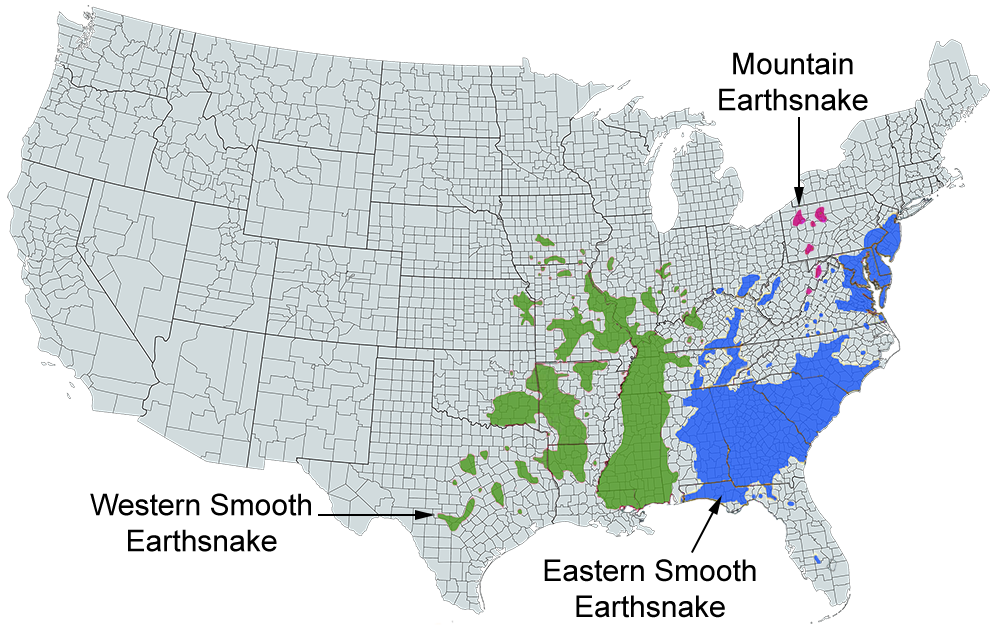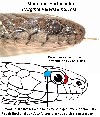Mountain Earthsnake
Virginia valeriae pulchra
** Harmless **
Common Name: |
Mountain Earthsnake |
Scientific Name: |
Virginia valeriae pulchra |
Etymology: |
|
Genus: |
Virginia is derived from the Latin word virgo which means "virgin". |
Species: |
valeriae is to honor Miss Valeria Blaney, the first documented collector of the species. |
Subspecies: |
pulchra is derived from the Latin word pulcher which means "beautiful". |
Vernacular Names: |
|
Average Length: |
11 in. (27.9 cm) |
Virginia Record Length: |
12.6 in. (32 cm) |
Record length: |
15.5 in. (39.3 cm) |
Systematics: Originally described as Virginia valeriae by Spencer Fullerton Baird and Charles Frederic Girard in 1853, based on a specimen (USNM 1962) from Kent County, Maryland. The name remained stable until Schmidt and Davis (1941) and Stejneger and Barbour (1943) used the genus Haldea for this species. Several authors in the Virginia literature subsequently used Haldea valeriae (e.g., Carroll, 1950; Werler and McCallion, 1951; Schmidt, 1953; Burger, 1958; Conant, 1958). Zillig (1958) showed that the original generic name, Virginia, was the oldest and, thus, the correct genus for this species. Other Virginia authors used the name Virginia valeriae before 1941 and after 1958 (e.g., Cope, 1900; Hay, 1902; Dunn, 1915a, 1915d, 1918, 1936; Richmond and Goin, 1938; Hardy, 1972; Mitchell, 1974b; Conant, 1975; Blem and Blem, 1985). Three subspecies are recognized: V. v. elegans Kennicott, V. v. pulchra (Richmond), and V. v. valeriae Baird and Girard. Blanchard (1923) determined that the snakes named as species by Baird and Girard (1853) V. valeriae and V. elegans were actually subspecies of V. valeriae. Richmond (1954b) described a third subspecies as Haldea valeriae pulchra (= V. v. pulchra) from Pennsylvania specimens. Distributions of these races were illustrated in Conant and Collins (1991) and Powell et al. (1992); Two of the subspecies occur in Virginia.
Description: A small snake reaching a maximum total length of 393 mm (15.5 inches) (Conant and Collins, 1991). In Virginia, maximum known snout-vent length (SVL) is 276 mm (10.9 inches) and maximum total length is 320 mm (12.6 inches). In this study, tail length/total length was 11.0-21.8% (ave. = 15.8 ± 3.0, n = 72).
Scutellation: Ventrals 107-128 (ave. = 117.3 ± 4.4, n = 74); subcaudals 22-45 (ave. = 30.0 ± 5.6, n = 71); ventrals + subcaudals 139-162 (ave. = 147.3 ± 5.1, n = 71); dorsal scales smooth (weakly keeled above cloacal region in males), scale rows 15 or 17 at midbody; anal plate divided; infralabials 6/6 (92.9%, n = 71) or other combinations of 5-7 (7.1%); supralabials 6/6 (94.7%, n = 75) or other combinations of 5-7 (5.3%); internasals 2; loreal scale present; no preoculars; postoculars 2/2; temporal scales usually 1+2/1+2 (92.1%, n = 38) or other combinations of 1-3 (7.9%).
Coloration and Pattern: Dorsum of body, head, and tail uniformly reddish brown to dark gray; adults often with an irregular pattern of tiny black flecks or spots on dorsum; venter uniformly cream; dorsum of entire head same color as body; a short, darkly shaded line may be present in front of eye; chin, infralabials, and supralabials white.
Subspecies: Virginia v. valeriae has 15 dorsal scale rows at midbody and smooth scales (except above the cloaca), and is usually gray. Virginia v. pulchra has 17 dorsal scale rows at midbody and weakly keeled scales, and is usually brownish.
Sexual Dimorphism: Adult female SVL averaged larger (214.5 ± 23.6 mm, 183-276, n = 30) than male SVL (171.4 ± 14.9 mm, 153-200, n = 20), and females reached a longer total length (320 mm, males 252 mm). Sexual dimorphism index was 0.25. Average tail length/total length was higher in males (18.7 ± 1.2%, 16.5-20.7, n = 31)) than females (13.6 ± 1.2%, 11.0-21.8, n = 41). Females possessed a higher average number of ventral scales (119.7 ± 3.7, 111-128, n = 42) than males (114.1 ± 3.1, 107-119, n = 32), but a lower average number of subcaudals (females 25.8 ± 2.7, 22-33, n = 39; males 35.1 ± 3.7, 29-45, n = 32). The average counts of ventrals + subcaudals in males (149.2 ± 5.4, 140-162, n = 32) was slightly higher than that in females (145.8 ± 4.3, 139-155, n = 39). There is no sexual dimorphism in color. Blem and Blem (1985) found that males and females from eastern Henrico County did not differ significantly in SVL, but did differ in tail lengths and counts of ventrals and subcaudals.
Juveniles: Juveniles are patterned and colored as adults at birth. A dark line in front of the eye is present. There is no light collar behind the head. Neonates from one litter measured 76-86 mm SVL (ave. = 82.4 ± 3.4, n = 8) and 92-103 mm total length (ave. = 98.4 ± 3.5), and weighed an average of 0.59 g.
Confusing Species: In Virginia, this species may be confused with several other small snakes. Haldea striatula has strongly keeled scales and 17 dorsal scale rows; juveniles have a light collar behind the head. Other potentially confusing species are in the H. striatula account.
Geographic Variation: Male V. v. pulchra in Virginia had a slightly higher average number of ventral scales (116.0 ± 2.2, 113-118, n = 4) and a higher average number of subcaudals (41.8 ± 2.9,38-45, n = 4) than male V. v. valeriae (ventrals 113.8 ± 3.2, 107-119, n = 28; subcaudals 34.1 ± 2.7, 29-40, n = 28). The total V. v. pulchra sample exhibited a higher average number of ventrals + subcaudals (157.2 ± 3.6, 154- 162, n = 5) than the sample of V. v. valeriae (146.6 ± 4.4, 139-156, n = 66). The largest known female Virginia valeriae in Virginia (320 mm total length) is a V. v. pulchra; the largest V. v. valeriae female is 308 mm total length.
Biology: Virginia valeriae is entirely terrestrial and inhabits hardwood forests, mixed hardwood-pine forests, pine woods, abandoned fields in various stages of succession, dry upland ridges, pastures, urban and suburban woodlots, forest-field ecotones, and moist lowlands. They can often be found under all manner of surface objects, such as boards, logs, trash, debris, and piles of leaves or straw. Much of the time is spent underground; N. D. Richmond (pers. comm.) reported plowing up a gravid female in New Kent County. Museum records indicate they are active 15 February to 13 December. Richmond (1954b) noted that most collections of more than one specimen of this species in Pennsylvania were preceded by 3.5-8.6 cm of rainfall over a 4-day period. Apparently increased soil moisture stimulates them to migrate to the surface.
Virginia valeriae preys on worms. This was the only prey type found in the Virginia specimens I examined. Blem and Blem (1985) found only worms in the snakes they examined from Henrico County. Wright and Wright (1957) and Linzey and Clifford (1981) noted that other prey included insect larvae, soft-bodied insects, and snails. The only known predators of this snake in Virginia are free-ranging domestic cats (Mitchell and Beck, 1992). Linzey and Clifford (1981) speculated that Northern Mole Kingsnakes (Lampropeltis calligaster), Eastern Milksnakes (L. triangulum), raccoons (Procyon lotor), and opossums (Didelphis virginiana) prey on this snake. Ernst and Barbour (1989b) reported that a specimen from Pennsylvania pretended to play dead after capture.
Mountain Earthsnake are viviparous. Mating probably occurs in spring and fall. Known birth dates for Virginia V. valeriae are July 23 through 4 August. Litter size was 2-9 (ave. = 6.5 ± 2.3, n = 11) for the specimens I examined. Blem and Blem (1985) reported an average litter size of 6.6 ±1.8 for five females from Henrico County. Fitch (1970) found an average litter size of 6.6 (2-12) based on specimens from throughout the species' range, and Ernst and Barbour (1989b) noted a litter size of 2-14.
Virginia valeriae is more common east of the mountains than west. None were found in the surveys of Uhler et al. (1939) in the George Washington National Forest or those of Martin (1976) in the Blue Ridge Mountains. Clifford (1976) found 4 individuals out of 278 in a 4-year study in Amelia County. The population ecology of this snake has not been studied. Smooth earth snakes will not bite when captured but may emit musk from the glands at the base of the tail and occasionally feces.
Remarks: Other common names for this snake in Virginia are Valeria's snake (Hay, 1902; Dunn, 1936); eastern ground snake (Carroll, 1950); and brown snake, worm snake, and ground snake (Linzey and Clifford, 1981).
Burger (1958) was the first to suggest that Virginia valeriae pulchra would be found in Highland County, Virginia. It was first found in the vicinity of Hightown, Highland County, in 1968 (letter from H. G. M. Jopson to F. J. Tobey, 14 February 1972), but the specimen was apparently not photographed, nor was it deposited in a museum collection. It was not until David A. Young collected it in the same general area on 3 June 1986 that it was verified as a member of Virginia's snake fauna.
Collins (1991) suggested that V. v. pulchra should be elevated to full species status, largely because it was allopatric with V. v. valeriae. This suggestion and others have not been verified or accepted by the herpetological community. Any taxonomic conclusion about the specific status of pulchra should await a definitive systematic study.
Conservation and Management: Virginia v. valeriae is not a species of special concern in Virginia due to its widespread occurrence. However, Virginia v. pulchra is listed in the special concern category (Mitchell, 1991b). This subspecies is also listed under Category 2 regulations by the U.S. Fish and Wildlife Service because of its rarity in all states in its range except Pennsylvania (Department of the Interior, 1991). The only known locality in Virginia is on private land, and various parts of that portion of Highland County are being logged for timber products. If this subspecies is elevated to full species status, then it should be at least considered for the threatened category at the state level.
Several steps are recommended for conserving and managing this snake. The full extent of its distribution in Virginia needs to be revealed, as does its ecological requirements and life history. We also need to determine the extent of logging threats and where selected populations should be protected. Management could include limitations on logging practices, exclusion of some areas from logging, and maintenance of open sunlit areas for gravid females.
References for Life History
Photos:
*Click on a thumbnail for a larger version.
Verified County/City Occurrence in Virginia
Highland
CITIES
Verified in 1 counties and 0 cities.
U.S. Range

US range map based on work done by The Center for North American Herpetology (cnah.org) and Travis W. Taggart.









